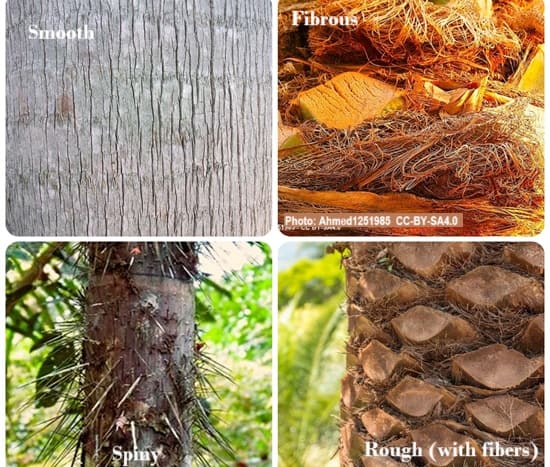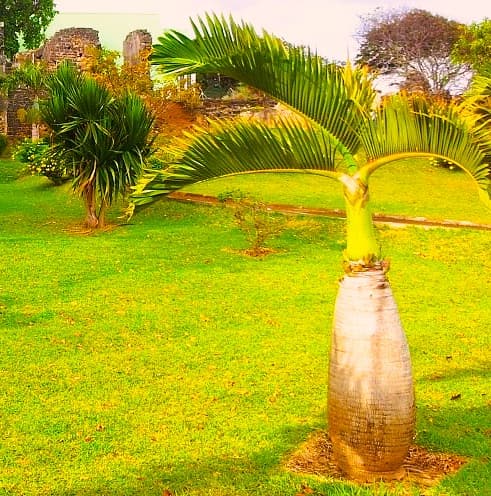The Palm Species Navigator

January 28, 2025: Welcome!

Can a Palm Trunk Reveal Identification?
The Art of Adding in Trunks for
Identifying Palm Trees Like a Pro!
Identifying a palm tree by viewing its trunk helps unlock the secret code to species identification! You notice we said "helps" - as that's just another item in your ID Toolbox.
Palm lovers, especially identification novices, might wonder if there's asecret to quickly know how to identify palms. But it takes all the clues put together to advance.
So this other clue which may be hidden in plain view - the palm trunk - is useful, too.

As someone who has spent time deciphering these palm puzzles, we're here to guide you in adding palm trunk decoding into the identification mystery.
Here we'll cover:
- Why add this reasoning step?
- Simple resource to use
- How to make this a fun, engaging experience
Here’s how to swing into ID action
with palm trunks:
Use these 3 Steps about Palm Trunks.
STEP 1: Texture Observation
Palms have multiple styles of trunk appearance. That aspect adds to your evaluation process.
Start by spotting the trunk's details, up close if possible. Palm trunks are woody, but they're not considered "bark" as in regular trees. Instead it's often called pseudobark.
Ask yourself:
Is the palm trunk's outer surface smooth, rough, spiny, or fibrous?

Many palm enthusiasts note texture to decide which form it naturally takes (so don't consider unnatural, sad weird pruning - like this one!).
 Oh, what a sad case! 😢
Oh, what a sad case! 😢- For example, the Christmas Palm (which we showed you last month) & the Chilean Wine Palm usually have a smooth trunk with faint ring markings.
 Chilean Wine Palm's Smooth Trunk
Chilean Wine Palm's Smooth Trunk- While the Pygmy Palm has a noticeably coarse texture remaining, from old leaf bases.
 Trunk coarseness on the Pygmy/Miniature Date Palm (Phoenix roebelinii)
Trunk coarseness on the Pygmy/Miniature Date Palm (Phoenix roebelinii)STEP 2: Color Examination
Trunk color can range from gray, brown or white, to shades of green. Noting these hues helps narrow down your options.
- The Mexican Fan Palm flaunts light gray to almost white tones.
- The Canary Island Date Palm has a more tan to brown tinge.
- And the Golden Cane Palm has distinctive rings amid the range of trunk color possibilities, from orange & yellow to dark green.
STEP 3: Shape and Size
Palm trunk's width & shape make a difference. As does height.
- Is it thick and stout like the Bismarck Palm?
- Is it tall and slender like the Quindío Wax Palms?
- Does it have odd bulges like the Bottle Palm?
 Hyophorbe lagenicaulis - The Bottle Palm
Hyophorbe lagenicaulis - The Bottle PalmApplying What You’ve Just Learned
First use this Palm Species Resource at Floridata to observe trunks of multiple palm species. Practice asking yourself about the 3 Steps in analyzing palm trunks.
Then GO LIVE by taking this knowledge to your favorite park or garden to test out what you've learned here.
Observe trunks closely, then check which species fit. Use a Palm Guidebook like this one that we highly recommend: [*ad] - Palms Throughout the World. We use it, for its fabulous helpful content with palm identification.
Here's what you learned today:
- Trunks hold key information for assisting species identification.
- Texture, color, shape & size are vital clues.
- It helps to familiarize yourself with all the varied types of palm trunks.
You'll get more deeply & accurately into palm identification, as time goes on. Yes, there is a lot to learn, but taking it step by step, without pressure, will help.
Your palm species ID journey can gradually advance. You may soon become the go-to palm expert in your friends' sphere!
Til Next Time,
Karen & Bill of Mission: Palm Trees

P.S. Don't miss Our Latest Articles - See what else we have for you, organized by subject, at our Mission: Palm Trees Site Index
P.P.S. Missed any Life Amid the Palms memos? Easily Check our past issues, by subject & date, of Life Amid the Palms Here>

